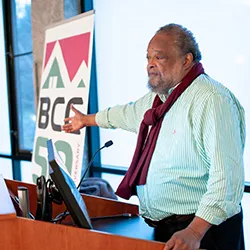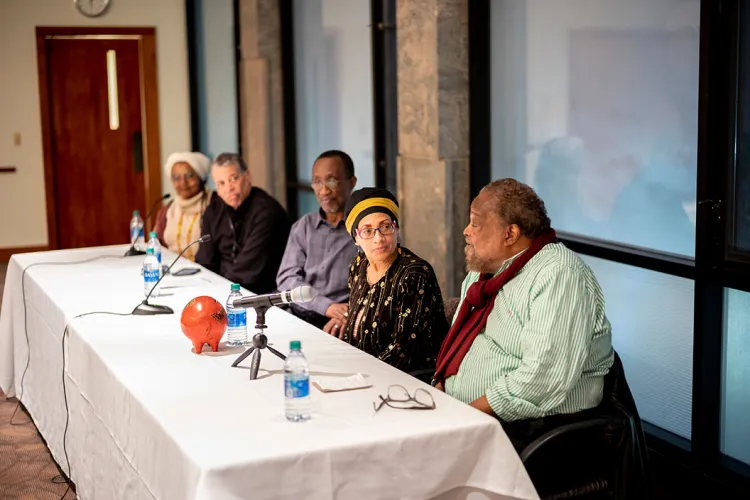Black Cultural Center Trailblazers Panel

As part of Swarthmore’s yearlong Celebration of Black Excellence, five alumni instrumental in establishing the College's Black Cultural Center (BCC) returned to campus 50 years later to discuss their efforts.
Their talk, held in the Scheuer Room and moderated by Joy George ’20, a Black studies and political science special major from the Bronx, N.Y., focused on the panel’s experiences during the Black student protest movement at Swarthmore, headed by the Swarthmore African-American Student Society (SASS) and the events that led to the BCC’s founding.
“The story I want to tell hasn’t really been told,” said Don Mizell '71, the self-described link between the 1969 Admissions Office sit-in and the efforts that followed to ensure that all of SASS' demands were met. He discussed the sit-in, the blame that came with the death of President Courtney Smith, and the stress he felt speaking for SASS during such a tumultuous time.
Panelists Rosalind Plummer '73, Jim White '73, G. Isaac Stanley '73, and Ashabi Rich ’76 joined Mizell in describing their successful efforts to lobby President Robert Cross to secure funding for the center. Mizell also credited Pulitzer Prize-winning author James Michener ’29, H’54, with providing $100,000 to help transform Robinson House into the BCC.
“We didn’t freak out. We didn’t quit. We didn’t burn down Parrish Hall. We came at it rationally,” said Mizell. He added that despite all of the resistance he and SASS faced, “you have a great college here, because it’s willing to grow and change.”
Each panelist also spoke about how instrumental the House was to their success at the the College. “There was something magical about leaving campus," Plummer said, "and having a place like home."
Alumni Reflections
Don Mizell '71, Swarthmore's first African American Watson Fellow; J.D., Harvard Law School; lawyer and creative executive, recipient of the 2005 Grammy Award for Album of the Year.
"'Why do you need a Black Cultural Center?' Well, we needed a safe harbor. We need a safe haven. We need a place where we can go and congregate and really just be with each other in a way that affirms our Blackness and our culture. We need that. And they didn't think that was all that important 'cause they thought it was separate. This was the issue. 'Why would y'all want to separate when you were fighting for integration?' But they didn't quite understand, it wasn't really separation. It was, we wanted a place that we could formulate our identity in a way that it had not been able to be done before by black folks in a white environment. It was just brutal, the degree to which you were supposed to deny your Blackness, the worth of your Blackness."
Rosalind Plummer ’73, M.A. and J.D., Harvard University; currently an instructor and supervising attorney for the Business Law Clinic of Temple University.
“Sitting in that space [in the BCC], where we could talk honestly, where we were free from eyes looking at us and forming opinions, where we could stop being combative and really be people. In that house, it felt like home, and magic worked. [...] We had different opinions, we debated, but it was all fine because we were family once we came into that house. And I felt that way when I came through the Black House before coming here [tonight]. It warmed me.”
G. Isaac Stanley ’73, MBA, Rider University; retired business analyst at MetLife; currently board chair of Ignite and board member for the Jackson Park Yacht Club for Youth Foundation in Chicago.
“When the [BCC] came into being, it was a place of refuge for me, where I could go and feel comfortable, where I could study and not feel like, ‘Okay, where’s this next aggression going to come from?’ Or, ‘Where’s this next microaggression going to come from?’ And just being around my brothers and my sisters here at the College was very reaffirming and supportive and, like Rosalind was saying, was family.”
Jim White ’73, former vice president of First Union National Bank in Philadelphia; CFO for Delaware River Port Authority.
“There were a number of us who experienced situations where professors were either blatant or subtle about the fact that [they thought] a lot of us didn’t belong here. And so the [BCC] was a place of camaraderie, a place of healing, a place of strength for us. Even going forward, I’m on the Alumni Gospel Choir, and even now when we rehearse, it’s not just about signing but it’s a family. We had a family of brothers and sisters who came together, and it was a wonderful thing.”
Ashabi Rich ’76, writer, dancer, retired early childhood educator; graduate student at Temple’s Klein College of Media Communication.
“The [Swarthmore African American Society and the BCC] was a home away from home. It was a safe place to be. We could go and just be black people. And we didn’t have to worry about other people’s opinions of what we were doing, of our hair, of our clothes, of our language, of anything. We did have some tough times with some of the professors who would stand in class and say we didn’t belong there. [...] I would say it was an incubation for a lot of us."




